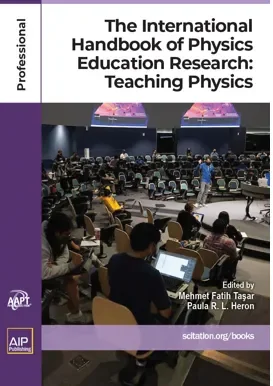

School of Physical Sciences: Book chapters published in International Handbook of Physics Education Research
Congratulations to Dr. Eilish McLoughlin, and Dr. Paul van Kampen on their book chapters in the International Handbook of Physics Education Research, published by AIP publishing. This seminal handbook covers the topics of educational technologies, learning environments, teacher education, and assessment in relation to physics education. As the field of physics education research grows, it is increasingly difficult for newcomers to gain an appreciation of the major findings across all sub-domains, discern global themes, and recognize gaps in the literature. The current volume incorporates the understanding of both physics and education concepts and provides an extensive review the literature in a wide range of important topics.
Eilish was responsible as section editor for research on “Physics Teacher Education” which presents a comprehensive overview of research studies that examine structures, strategies, and challenges to the professional learning of teachers of physics across the educational levels from early childhood to university level. Eilish co-authored the chapter on Physics Teacher Professional Learning with Dr Dagmara Sokolowska from Jagiellonian University in Krakow, Poland. The research indicates that the focus of in-service physics teacher education generally consists of developing teachers' physics content knowledge with some focus on developing teacher’s pedagogical content knowledge for teaching physics. Strategies for reflective, collaborative interaction between teachers and researchers, focused on reinforcing teacher’s confidence in teaching physics and developing their competencies for long-life learning are presented.Overall, this chapter explores the state-of-the-art of teacher professional development and how these strategies can be utilised to support physics teachers in designing teaching and learning activities that address the needs of future physics learners. Link to chapter https://aip.scitation.org/doi/full/10.1063/9780735425712_015
Paul co-authored a chapter on students’ understanding of electricity and magnetism with Professor Mieke de Cock of KU Leuven. The research reviewed spans all age groups and includes work carried out within a wide variety of frameworks. It starts with students’ ideas about electric charge, attraction and repulsion, charging, polarization, and magnetic interactions primarily from a qualitative viewpoint. It then describes research related to students adopting a more quantitative approach: electrostatic and magnetostatic force and field; the superposition principle; electric potential, electric potential energy, and capacitance. Sections on representations and commonly used diagnostic tests serve as a bridge to more advanced topics that often also require more advanced mathematical techniques such as integration and vector calculus: Gauss’ Law, Ampère’s Law, and Faraday’s Law. Throughout the chapter the authors highlight where they have found gaps in the literature. Link to chapter: https://doi.org/10.1063/9780735425477_005
